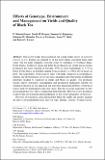| dc.description.abstract | The tea beverages processed from the young tender shoots of Camellia sinensis
(L.) O. Kuntze, are claimed to be the most widely consumed fluids after water. The tea plant
originates from the point of confluence of Northeast India, North Burma, Southwest China
and Tibet. Its production has spread and economic production has been reported in
between 49∘ N in Outer Carpathians to 33∘ S in Natal, South Africa, at altitudes ranging
from sea level to 2,700 m above mean sea level. The adaptability of the plant to areas with
large variations in geographical, climatic and environmental factors can cause changes in
growth patterns in different genotypes leading to variations in yields and black tea quality.
Tea producers usually import genotypes, management and production techniques suitable
for optimal production in one region in the hope that beneficial attributes observed at … | en_US |

